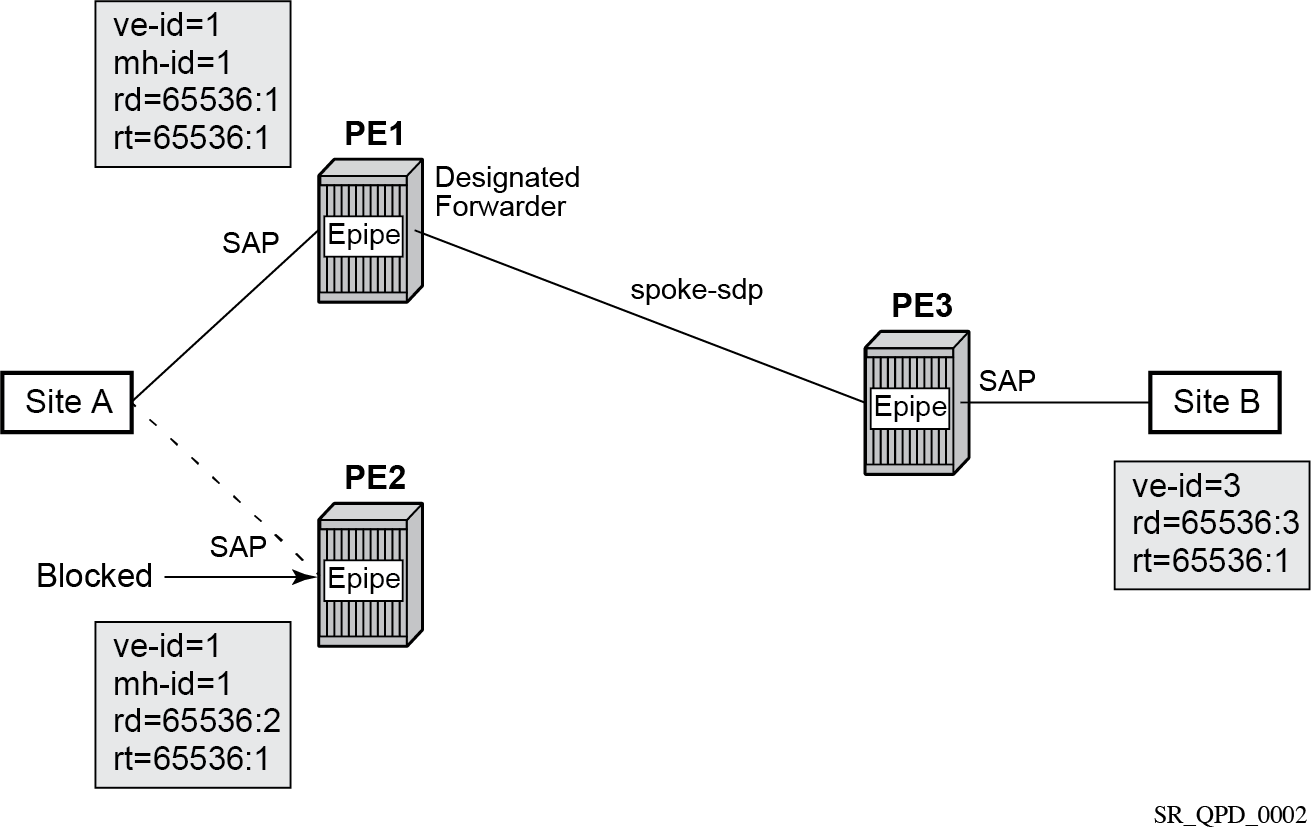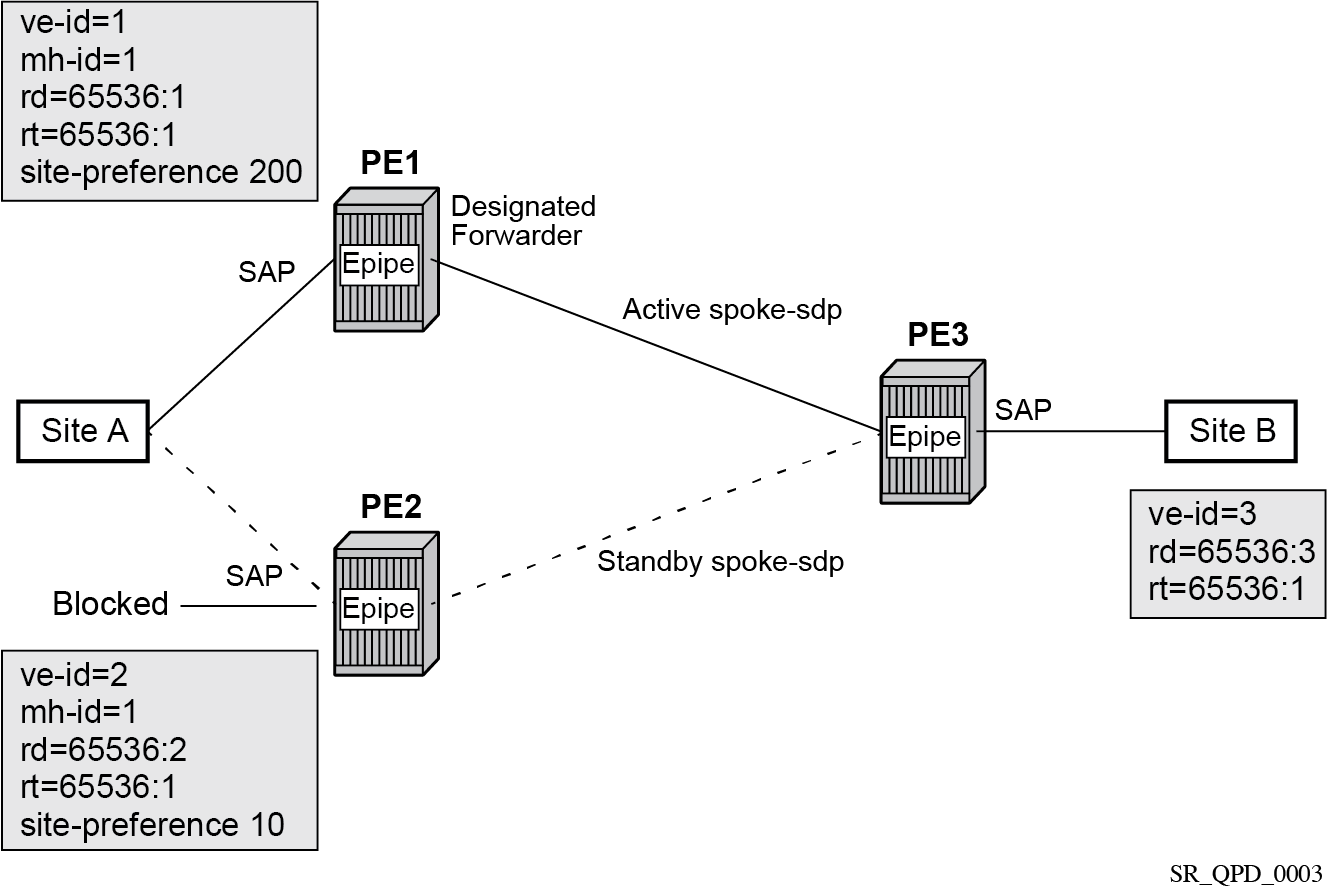Single pseudowire example:
The following figure shows an example topology for a dual-homed BGP VPWS service used to create a virtual lease line (VLL) across an MPLS network between sites A and B. A single pseudowire is established between the designated forwarder of the dual-homed PEs and the remote PE.

An Epipe with BGP VPWS enabled is configured on each PE. Site A is dual-homed to PE1 and PE2 with a remote PE (PE3) connected to site B; each connection uses a SAP. A single pseudowire using Ethernet Raw Mode encaps connects PE3 to PE1. The pseudowire is signaled using BGP VPWS over a tunnel LSP between the PEs.
Site A is configured on PE1 and PE2 with the BGP route selection, the site state, and the site-preference used to ensure PE1 is the designated forwarder when the network is fully operational.
The following example shows the BGP VPWS configuration on each PE.
The following example shows the configuration on PE1:
pw-template 1 create
exit
epipe 1 customer 1 create
bgp
route-distinguisher 65536:1
route-target export target:65536:1 import target:65536:1
pw-template-binding 1
exit
exit
bgp-vpws
ve-name PE1
ve-id 1
exit
remote-ve-name PE3
ve-id 3
exit
no shutdown
exit
sap 1/1/1:1 create
exit
site "siteA" create
site-id 1
sap 1/1/1:1
boot-timer 20
site-activation-timer 5
no shutdown
exit
no shutdown
exit
The following example shows the configuration on PE2:
pw-template 1 create
exit
epipe 1 customer 1 create
bgp
route-distinguisher 65536:2
route-target export target:65536:1 import target:65536:1
pw-template-binding 1
exit
exit
bgp-vpws
ve-name PE2
ve-id 1
exit
remote-ve-name PE3
ve-id 3
exit
no shutdown
exit
sap 1/1/1:1 create
exit
site "siteA" create
site-id 1
sap 1/1/1:1
boot-timer 20
site-activation-timer 5
no shutdown
exit
no shutdown
exit
The following example shows the configuration on PE3:
pw-template 1 create
exit
epipe 1 customer 1 create
bgp
route-distinguisher 65536:3
route-target export target:65536:1 import target:65536:1
pw-template-binding 1
exit
exit
bgp-vpws
ve-name PE3
ve-id 3
exit
remote-ve-name PE1orPE2
ve-id 1
exit
no shutdown
exit
sap 1/1/1:1 create
exit
no shutdown
exit
Active/standby pseudowire example:
The following figure shows an example topology for a dual-homed BGP VPWS service used to create a VLL across an MPLS network between sites A and B. Two pseudowires are established between the remote PE and the dual-homed PEs. The active pseudowire used for the traffic is the one connecting the remote PE to the designated forwarder of the dual-homed PEs.

An Epipe with BGP VPWS enabled is configured on each PE. Site A is dual-homed to PE1 and PE2 with a remote PE (PE3) connected to site B; each connection uses a SAP. Active/standby pseudowires using Ethernet Raw Mode encapsulation connect PE3 to PE1 and PE2, respectively. The pseudowires are signaled using BGP VPWS over a tunnel LSP between the PEs.
Site A is configured on PE1 and PE2 with the site-preference set to ensure that PE1 is the designated forwarder when the network is fully operational. An endpoint is automatically created on PE3 in which the active/standby pseudowires are created.
The following example shows the BGP VPWS configuration on each PE.
Example: Dual-homed BGP VPWS configuration with active/standby pseudowires on PE1:
pw-template 1 create
exit
epipe 1 customer 1 create
bgp
route-distinguisher 65536:1
route-target export target:65536:1 import target:65536:1
pw-template-binding 1
exit
exit
bgp-vpws
ve-name PE1
ve-id 1
exit
remote-ve-name PE3
ve-id 3
exit
no shutdown
exit
sap 1/1/1:1 create
exit
site "siteA" create
site-id 1
sap 1/1/1:1
boot-timer 20
site-activation-timer 5
site-preference 200
no shutdown
exit
no shutdown
exit
Example: Dual-homed BGP VPWS configuration with active/standby pseudowires on PE2:
pw-template 1 create
exit
epipe 1 customer 1 create
bgp
route-distinguisher 65536:2
route-target export target:65536:1 import target:65536:1
pw-template-binding 1
exit
exit
bgp-vpws
ve-name PE2
ve-id 2
exit
remote-ve-name PE3
ve-id 3
exit
no shutdown
exit
sap 1/1/1:1 create
exit
site "siteA" create
site-id 1
sap 1/1/1:1
boot-timer 20
site-activation-timer 5
site-preference 10
no shutdown
exit
no shutdown
exit
Example: Dual-homed BGP VPWS configuration with active/standby pseudowires on PE3:
pw-template 1 create
exit
epipe 1 customer 1 create
bgp
route-distinguisher 65536:3
route-target export target:65536:1 import target:65536:1
pw-template-binding 1
exit
exit
bgp-vpws
ve-name PE3
ve-id 3
exit
remote-ve-name PE1
ve-id 1
exit
remote-ve-name PE2
ve-id 2
exit
no shutdown
exit
sap 1/1/1:1 create
exit
no shutdown
exit